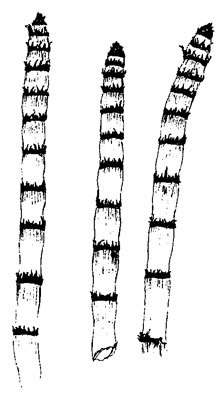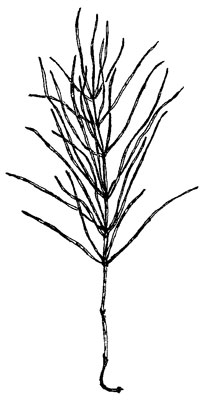 |
| Equisetum hyemale is the species of horsetail that grows in the mid-South, while E. arvense (below) grows in New England. Both species benefit bones and other aspects of health. Illustrations by Leslie Wood. |
 |
By Leslie Wood, with Fredda Paul
Spring shoots of horsetail have just begun to come up from the earth. In the early morning on a small hill in a sandy field, we give thanks with intentions for the harvest. In a chorus of light and redwing blackbirds, we sing for the earth, offer prayers and leave offerings. Then, silently, each goes alone to participate in a way from the past. Timing is important – spring shoots make the essential medicine. In Kentucky and Indiana we harvest Equisetum hyemale. In Maine, Equisetum arvense is more common.
A Field of Horsetail is Timeless
Walk through time and locale with this ancient fern and you’ll see an enormous capacity to heal both the earth and humans. Wonder at it – rhizomes have been found 6 feet below ground; plants can survive bulldozing, flood, fire and drought. Dating back 350 million years, the Equisetum species are among the oldest of all plants. At the Field Museum in Chicago, you can see replicas of giant horsetail trees, which once grew 100 feet tall. Today, rushes of Equisetum hyemale grow to 6 feet. Like miniature feathery trees, Equisetum arvense grows prolifically along roadsides and in uncultivated fields. Some gardeners call it invasive; healers and seers know it’s a gift – as are all the persistent weeds.
Silica – Bioavailable and Healing
Silica is the most abundant element on the earth’s crust, yet a very small amount is bioavailable. In comes horsetail – next to diatoms it has more silica than any other plant, and that silica is most bio-available in the spring shoots.
Silica plays an active role in calcium metabolism. Silica is a primary element in the formation and repair of bone, cartilage, connective tissue and skin. Silica is essential for a healthy heart and arteries.
Osteoporosis is epidemic. Though not a magic potion, horsetail could help – using spring shoots in concentrated form has achieved amazing and rapid results in the process of recalcifying bones.
According to the National Institutes of Health, bone loss can be attributed to a sedentary lifestyle; consuming excessive caffeine, soft drinks, alcohol or tobacco; long-term use of certain anti-seizure drugs, thyroid hormone supplements, antibiotics, antidepressants or antihistamines; or even something as simple as not drinking enough water.
A Multipurpose Plant
On my knees I find spring shoots of Equisetum hyemale hidden among the rushes. Spines rise strong like bones of the earth. Signs and signatures in plants are mysterious ways we are given clues to their purpose. In horsetail, you’ll see much that has to do not only with bones, but with the flow of water, with resiliency, energy and an array of other benefits.
Every year I get calls, letters and e-mails from women who have started using horsetail in this form. The stories are exciting.
“My hair has stopped splitting and breaking off, and my fingernails are hard as rocks.”
“I returned for another bone density scan after 6 months and had a 7% bone mass increase!”
“My client cancelled her carpal tunnel surgery.”
“My chronic back pain is gone!”
“In just two weeks, my mother’s fungus toes, they began to get new white growth.”
“I can now climb the stairs without holding the handrail.”
Because horsetail can absorb minerals better than most other plants, it is used by agronomists to check for mercury and other pollutants in the soil. Similarly, if a soil contains gold, it will be avidly absorbed – the ash from a ton of stems sometimes yielded a return of more than 150 dollars. One of the benefits of horsetail is its ability to detoxify heavy metals from the body. The minerals from horsetail act as a kind of chelator, passing the waste out through the kidneys. Horsetail can restore vitality to the kidneys by helping relieve these most precious organs of acid buildup.
Horsetail has a variety of anti-fungal uses. As a garden spray, a small handful of dried herb simmered in a quart of water for 10 minutes will eliminate molds. Biodynamic farmers provide their animals with horsetail tea when they get hoof rot. They make it by the barrel and splay it on their fields with a whiskbroom.
Fredda – “My grandmother taught me medicine.”
What my grandmother knew she learned from other elders and from her own dreams. She used horsetail a lot, and I would often go with her to gather it. We used to be able to find tons of it, but construction has wiped it out around here.
She made tea from fresh plants, or a tonic from spring shoots to last through the year. The tonic was used mostly for old people, to help their bones. They were to take a tablespoon a day divided into three doses, so that the body could absorb the medicine.
Horsetail stops bleeding, both internally and externally. A poultice of the fresh plant, the tonic, or a tea can be used for injuries, swellings and rashes; it penetrates right through the skin. Gram would tell people to rub it in three rounds, especially on old wounds and rashes. The dry skin on top will be penetrated, and the person begins to feel it on the second round. Then on the third round the real healing comes in. That’s for old wounds.
To make the tonic, my grandmother preferred brandy. She experimented with vodka, but found brandy worked the quickest and most thoroughly, taking the medicine right to the cells. She would get large bottles of brandy to preserve spring horsetail. She’d pack the spring shoots in a jar and pour brandy over them, leaving the mixture from full moon to full moon before straining it off. She said medicines are more powerful when made this way.
For kidneys, tea from the dry herb should be used so that healing won’t be too fast. To make tea, pour eight ounces of boiling water over 4 level tsp. of dried herb. Cover and steep for 3 minutes. A delicate person should drink no more than 1-1/2 cups a day, after meals, in divided doses. Sometimes a horsetail bath helps. For this, use 7 ounces of dried herbs or 6 quarts of fresh herb. Soak the horsetail overnight in enough cold water to cover the plants. In the morning, heat and strain off the liquid. Enjoy a 20-minute soak.
Horsetail Juice – Preparation and Dosage
Harvest spring shoots of horsetail and make a tonic as Fredda’s grandmother did, or make an herbal succus (Latin for “juice”). A succus (plural is succi) is made by grinding, blending or mashing the fresh plant and slowly expressing the juice under high pressure in a good tincture press; or by using a slow, strong juicer – the “Green Power” works great.
I have always used E. hyemale because I find it in my area of Kentucky, it is easy to juice, and people get good results with it. In Kentucky, the harvest is in May; it will be later in Maine. Pick spring shoots that are 8 to 10 inches tall. For each 4 ounces of juice, add 2 ounces of vodka or brandy to preserve. Store the mixture in the refrigerator – it will be quite potent for 16 months.
Using the above recipe, various people have achieved results with the following dosages. (This is not intended as advice.)
Extreme pain, injury, herniated disc, etc. – 1 Tbsp. 3x/day.
Early stages of loss of bone mass; fungal situations – 1 tsp./day, divided or in one dose. A quart should last about a year.
Maintenance and prevention – 30 to 45 drops/day. As little as 15 to 20 drops can make a difference.
To avoid irritating your kidneys and intestines, do not use horsetail for more than two weeks in a row, followed by a week of rest. Fredda’s grandmother advised this as well.
Possible Side Effects
Horsetail is a diuretic and has a cleansing effect on the kidneys. Potassium or mineral supplementation may be necessary with long term use – leg cramps signal deficiencies of these minerals. Horsetail increases circulation – people who tend to have hemorrhoids could experience a flare up. To prevent this, start slow, with 15 to 20 drops once a day. People with high blood pressure should exercise the same caution; horsetail thins the blood. For people who tend to hemorrhage, this should be noted.
Consuming large quantities has caused toxicity in livestock.
About the authors: This past year Leslie came from Kentucky to Maine to apprentice to Fredda Paul, traditional healer of the Passamaquoddy tribe, and help to record knowledge of plant medicine that Fredda has gleaned from Native elders. They teach workshops on traditional medicine on the reserve at Sipayik, Pleasant Point, Maine (near Eastport), and can be reached at (207) 853-4578 or [email protected]. Their book, Common Ground – Wild and Native Plants as Food and Medicine, is reviewed in this MOF&G.

